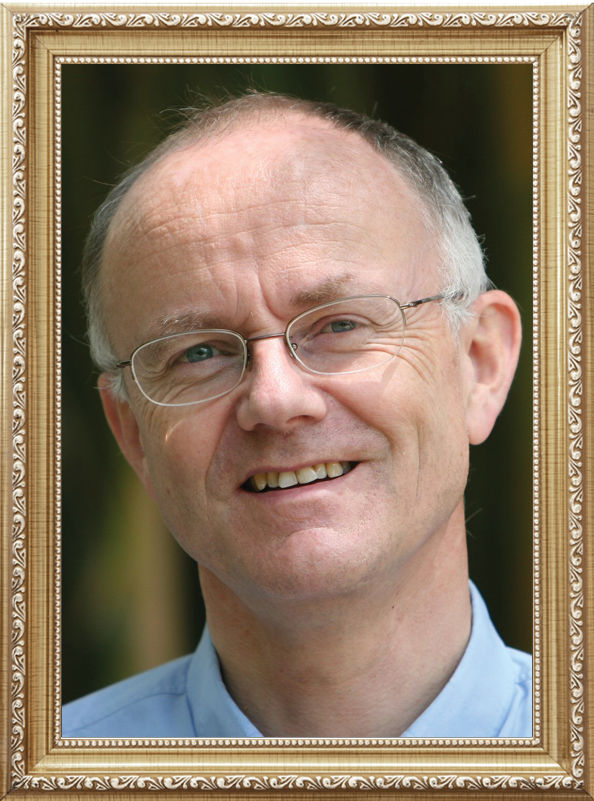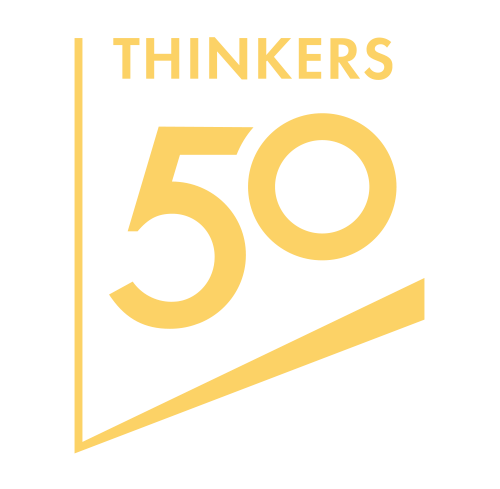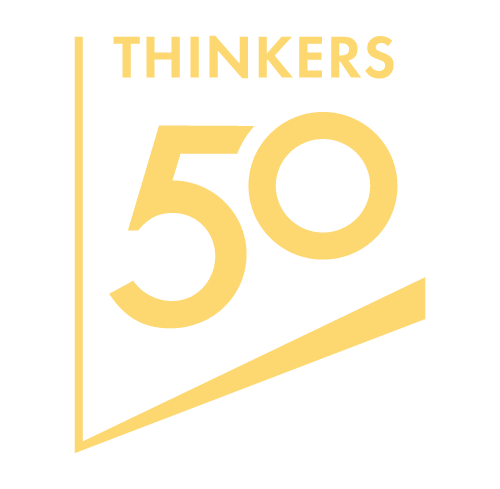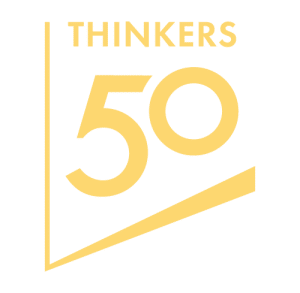The business world is fickle and has a short memory. This is especially true in the world of business ideas. New tools and techniques are put to work and then taken for granted as they are incorporated into business life. The quest for novelty and differentiation means that curious business leaders move quickly onto the next big idea. This is reflected in the Thinkers50 Ranking, which is a barometer of the ideas and thinkers making an impact today.
This relentless curiosity is a good thing. But, it can mean that over time the names of those who originated the most innovative business ideas and inspired best practice are overlooked or forgotten. Through the Thinkers50 Hall of Fame we salute the distinguished thinkers whose contributions to management thinking have made it what it is today.
Every year we honour the contribution of a few individuals by inducting them into the Thinkers50 Hall of Fame. Their names and legacies are added to the ranks of those who have arrived here before them. All are distinguished thinkers who have all made a lasting and vital impact on how organisations are led and managed. They are the giants upon whose shoulders managers and leaders stand.
Thinkers50 Hall of Fame status is at the discretion of the Thinkers50 founders, Stuart Crainer and Des Dearlove, and their advisors. It is an honour given in recognition of an outstanding and exceptional contribution to management thinking over many years.
EVERY YEAR IN SEPTEMBER
The Edsel Bryant Ford Professor of Business Administration, Emerita, at Harvard Business School, Teresa Amabile’s most recent book (with Lotte Bailyn, Marcy Crary, Douglas T. Hall, and Kathy E. Kram), Retiring: Creating a Life That Works for You, presents insights from a decade of research on the psychological, social, and life restructuring challenges of retiring. Before turning her research interests to the retirement transition, Teresa devoted over 40 years to researching creativity and innovation. She was instrumental in establishing the social psychology of creativity – the study of how the social environment can influence creative behaviour, primarily by influencing motivation. Her research on creativity appears in her books, Creativity in Context and Growing Up Creative. Extending that research, she next studied how everyday life inside organisations can influence people and their creativity, productivity, commitment, and collegiality, by affecting inner work life – the confluence of motivation, emotions, and perceptions. The findings of that research appear in The Progress Principle: Using Small Wins to Ignite Joy, Engagement, and Creativity at Work (with Steven Kramer).
As a psychologist the relationship between people and organisations has long intrigued Lynda Gratton. She has spent her working life seeking to understand more about this complex and highly impactful bond. As a Professor of Management Practice at London Business School, she designed the Human Resource Strategy in Transforming Companies programme and has since led it for over 20 years. She founded the advisory practice HSM Advisory and since 2008 has led the Future of Work by HSM which has brought together executives from more than 100 companies to imagine the future.
Lynda’s ten books cover the link between business and HR strategy (Living Strategy), the new ways of working (The Democratic Enterprise), the rise of complex collaboration (Hot Spots and Glow), the socially responsible roles of corporations (The Key), and the impact of a changing world on employment and work (The Shift, The 100-Year Life and The New Long Life).
Born in India and China respectively, Anil Gupta and Haiyan Wang joined their passion and over 60 years of research, consulting, and global business management experiences to establish the China India Institute in 2007. The Washington DC-based research and advisory organisation focuses on creating winning global strategies, organisations and mindsets that leverage the transformational rise of emerging markets, foremost China and India. Haiyan has been an Adjunct Professor of Strategy at INSEAD. Anil is the Michael Dingman Chair in Strategy, Globalization and Entrepreneurship at the Smith School of Business, The University of Maryland. He is a Distinguished Visiting Professor at Tsinghua University, China and Indian Institute of Technology, Bombay and has earlier served as a Chaired Professor in Strategy at INSEAD and a visiting professor at Stanford University and Dartmouth College. Haiyan and Anil are the authors of The Silk Road Rediscovered (with Girija Pandeh), Getting China and India Right and The Quest for Global Dominance (with Vijay Govindarajan). Anil is also the coauthor of Smart Globalization and Global Strategy and Organization.

In 1988 Lars Kolind was asked to rescue troubled hearing aid manufacturer Oticon. Under his leadership, Oticon became the world’s first truly networked organization, the world’s first (almost) paperless organisation and the world’s first knowledge-based office design. It offered a radically new model for employee engagement and collaborative ownership, a new model for engament of the dealership network, a new concept for patient engagement and a series of breakthrough products. It was described as a ‘spaghetti organisation’. Kolind and his team took Oticon public in 1995. He left the company in 1998 and then became chairman of Grundfos. He now holds numerous board positions (including being chairman of the World Scout Foundation) and is a serial entrepreneur—he has co-founded more than 25 companies and organisations during the last 20 years. He is adjunct professor of leadership and strategy at University of Aarhus and honorary president of the European Summer School for Advanced Management. He is also visiting lecturer at the Wharton School. Lars is DeTao Master of Leadership and Strategy at the DeTao Masters Academy in China. He is the author (with Jacob Bøtter) of Unboss.

While the titans of quality and Japan’s corporate renaissance in the 1970s and 1980s are well known in the West, there is little awareness of the role of Shibusawa Eiichi in developing modern Japanese society and industry. Yet, he was involved in the founding of some 500 enterprises and economic organisations. Away from commerce, he was instrumental in the founding of some 600 organisations for social welfare, education, and international exchange. One of Shibusawa’s formative experiences was visiting Europe as part of Japan’s delegation to the Paris Universal Exposition. Soon after returning he took part in founding and managing the joint-stock corporation Shizuoka Shoho Kaisho. As his interests developed he became a key figure in private-sector diplomacy, especially in building Japan-US relations. His key management contribution is the idea of the ‘analects and the abacus’. He imagined an ideal world in which commerce and government acted in tandem. In particular, he saw corporations as generators of wealth and also of social benefits.

Thinkers50 Limited
The Studio
Highfield Lane
Wargrave RG10 8PZ
United Kingdom

Thinkers50 Limited
The Studio
Highfield Lane
Wargrave RG10 8PZ
United Kingdom

Thinkers50 Limited
The Studio
Highfield Lane
Wargrave RG10 8PZ
United Kingdom
| Cookie | Duration | Description |
|---|---|---|
| LANG | 9 hours | Linkedin set this cookie to set user's preferred language. |
| nsid | session | This cookie is set by the provider PayPal to enable the PayPal payment service in the website. |
| sp_landing | 1 day | The sp_landing is set by Spotify to implement audio content from Spotify on the website and also registers information on user interaction related to the audio content. |
| sp_t | 1 year | The sp_t cookie is set by Spotify to implement audio content from Spotify on the website and also registers information on user interaction related to the audio content. |
| tsrce | 3 days | PayPal sets this cookie to enable the PayPal payment service in the website. |
| x-pp-s | session | PayPal sets this cookie to process payments on the site. |
| __cf_bm | 30 minutes | This cookie, set by Cloudflare, is used to support Cloudflare Bot Management. |
| Cookie | Duration | Description |
|---|---|---|
| l7_az | 30 minutes | This cookie is necessary for the PayPal login-function on the website. |
| Cookie | Duration | Description |
|---|---|---|
| CONSENT | 2 years | YouTube sets this cookie via embedded youtube-videos and registers anonymous statistical data. |
| _ga | 2 years | The _ga cookie, installed by Google Analytics, calculates visitor, session and campaign data and also keeps track of site usage for the site's analytics report. The cookie stores information anonymously and assigns a randomly generated number to recognize unique visitors. |
| _gat_gtag_UA_10408481_1 | 1 minute | Set by Google to distinguish users. |
| _ga_ZP8HQ8RZXS | 2 years | This cookie is installed by Google Analytics. |
| _gid | 1 day | Installed by Google Analytics, _gid cookie stores information on how visitors use a website, while also creating an analytics report of the website's performance. Some of the data that are collected include the number of visitors, their source, and the pages they visit anonymously. |
| Cookie | Duration | Description |
|---|---|---|
| NID | 6 months | NID cookie, set by Google, is used for advertising purposes; to limit the number of times the user sees an ad, to mute unwanted ads, and to measure the effectiveness of ads. |
| test_cookie | 15 minutes | The test_cookie is set by doubleclick.net and is used to determine if the user's browser supports cookies. |
| VISITOR_INFO1_LIVE | 5 months 27 days | A cookie set by YouTube to measure bandwidth that determines whether the user gets the new or old player interface. |
| YSC | session | YSC cookie is set by Youtube and is used to track the views of embedded videos on Youtube pages. |
| yt-remote-connected-devices | never | YouTube sets this cookie to store the video preferences of the user using embedded YouTube video. |
| yt-remote-device-id | never | YouTube sets this cookie to store the video preferences of the user using embedded YouTube video. |
| yt.innertube::nextId | never | This cookie, set by YouTube, registers a unique ID to store data on what videos from YouTube the user has seen. |
| yt.innertube::requests | never | This cookie, set by YouTube, registers a unique ID to store data on what videos from YouTube the user has seen. |
| Cookie | Duration | Description |
|---|---|---|
| DEVICE_INFO | 5 months 27 days | No description |
| loglevel | never | No description available. |
| m | 2 years | No description available. |
Thinkers50 Limited has updated its Privacy Policy on 28 March 2024 with several amendments and additions to the previous version, to fully incorporate to the text information required by current applicable date protection regulation. Processing of the personal data of Thinkers50’s customers, potential customers and other stakeholders has not been changed essentially, but the texts have been clarified and amended to give more detailed information of the processing activities.